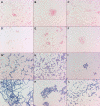Quantitative determination by real-time PCR of four vaginal Lactobacillus species, Gardnerella vaginalis and Atopobium vaginae indicates an inverse relationship between L. gasseri and L. iners
- PMID: 18093311
- PMCID: PMC2233628
- DOI: 10.1186/1471-2180-7-115
Quantitative determination by real-time PCR of four vaginal Lactobacillus species, Gardnerella vaginalis and Atopobium vaginae indicates an inverse relationship between L. gasseri and L. iners
Abstract
Background: Most studies of the vaginal microflora have been based on culture or on qualitative molecular techniques. Here we applied existing real-time PCR formats for Lactobacillus crispatus, L. gasseri and Gardnerella vaginalis and developed new formats for Atopobium vaginae, L. iners and L. jensenii to obtain a quantitative non culture-based determination of these species in 71 vaginal samples from 32 pregnant and 28 non-pregnant women aged between 18 and 45 years.
Results: The 71 vaginal microflora samples of these women were categorized, using the Ison and Hay criteria, as refined by Verhelst et al. (2005), as follows: grade Ia: 8 samples, grade Iab: 10, grade Ib: 13, grade I-like: 10, grade II: 11, grade III: 12 and grade IV: 7.L. crispatus was found in all but 5 samples and was the most frequent Lactobacillus species detected. A significantly lower concentration of L. crispatus was found in grades II (p < 0.0001) and III (p = 0.002) compared to grade I. L. jensenii was found in all grades but showed higher concentration in grade Iab than in grade Ia (p = 0.024). A. vaginae and G. vaginalis were present in high concentrations in grade III, with log10 median concentrations (log10 MC), respectively of 9.0 and 9.2 cells/ml. Twenty (38.5%) of the 52 G. vaginalis positive samples were also positive for A. vaginae. In grade II we found almost no L. iners (log10 MC: 0/ml) but a high concentration of L. gasseri (log10 MC: 8.7/ml). By contrast, in grade III we found a high concentration of L. iners (log10 MC: 8.3/ml) and a low concentration of L. gasseri (log10 MC: 0/ml). These results show a negative association between L. gasseri and L. iners (r = -0.397, p = 0.001) and between L. gasseri and A. vaginae (r = -0.408, p < 0.0001).
Conclusion: In our study we found a clear negative association between L. iners and L. gasseri and between A. vaginae and L. gasseri. Our results do not provide support for the generally held proposition that grade II is an intermediate stage between grades I and III, because L. gasseri, abundant in grade II is not predominant in grade III, whereas L. iners, abundant in grade III is present only in low numbers in grade II samples.
Figures



Similar articles
-
Influence of Lactobacillus crispatus, Lactobacillus iners and Gardnerella vaginalis on bacterial vaginal composition in pregnant women.Arch Gynecol Obstet. 2021 Aug;304(2):395-400. doi: 10.1007/s00404-021-05978-z. Epub 2021 Feb 1. Arch Gynecol Obstet. 2021. PMID: 33521838
-
Longitudinal qPCR study of the dynamics of L. crispatus, L. iners, A. vaginae, (sialidase positive) G. vaginalis, and P. bivia in the vagina.PLoS One. 2012;7(9):e45281. doi: 10.1371/journal.pone.0045281. Epub 2012 Sep 21. PLoS One. 2012. PMID: 23028904 Free PMC article.
-
Comparison between Gram stain and culture for the characterization of vaginal microflora: definition of a distinct grade that resembles grade I microflora and revised categorization of grade I microflora.BMC Microbiol. 2005 Oct 14;5:61. doi: 10.1186/1471-2180-5-61. BMC Microbiol. 2005. PMID: 16225680 Free PMC article.
-
[Bacterial vaginosis in 2011: a lot of questions remain].Gynecol Obstet Fertil. 2012 Jan;40(1):31-6. doi: 10.1016/j.gyobfe.2011.10.013. Epub 2011 Dec 22. Gynecol Obstet Fertil. 2012. PMID: 22197267 Review. French.
-
[The bacterial vaginosis--treatment problems].Wiad Lek. 2007;60(1-2):64-7. Wiad Lek. 2007. PMID: 17607971 Review. Polish.
Cited by
-
Fine-scale analysis of 16S rRNA sequences reveals a high level of taxonomic diversity among vaginal Atopobium spp.Pathog Dis. 2015 Jun;73(4):ftv020. doi: 10.1093/femspd/ftv020. Epub 2015 Mar 15. Pathog Dis. 2015. PMID: 25778779 Free PMC article.
-
Longitudinal study of the vaginal microbiome in pregnancies involving preterm labor.Fujita Med J. 2022 Aug;8(3):96-101. doi: 10.20407/fmj.2021-017. Epub 2021 Nov 25. Fujita Med J. 2022. PMID: 35949516 Free PMC article.
-
Long-term Lactobacillus rhamnosus BMX 54 application to restore a balanced vaginal ecosystem: a promising solution against HPV-infection.BMC Infect Dis. 2018 Jan 5;18(1):13. doi: 10.1186/s12879-017-2938-z. BMC Infect Dis. 2018. PMID: 29304768 Free PMC article. Clinical Trial.
-
Vaginal microbiota evaluation and prevalence of key pathogens in ecuadorian women: an epidemiologic analysis.Sci Rep. 2020 Oct 27;10(1):18358. doi: 10.1038/s41598-020-74655-z. Sci Rep. 2020. PMID: 33110095 Free PMC article.
-
Clinical Manifestations of Polycystic Ovary Syndrome and Associations With the Vaginal Microbiome: A Cross-Sectional Based Exploratory Study.Front Endocrinol (Lausanne). 2021 Apr 23;12:662725. doi: 10.3389/fendo.2021.662725. eCollection 2021. Front Endocrinol (Lausanne). 2021. PMID: 33967963 Free PMC article.
References
-
- Watts DH, Krohn MA, Hillier SL, Eschenbach DA. Bacterial vaginosis as a risk factor for post-cesarean endometritis. Obstet Gynecol. 1990;75:52–58. - PubMed
Publication types
MeSH terms
Substances
LinkOut - more resources
Full Text Sources
Other Literature Sources
Medical
Molecular Biology Databases

